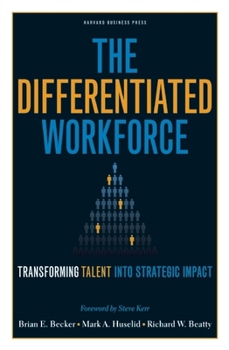The Differentiated Workforce: Translating Talent Into Strategic Impact
Select Format
Select Condition 
Book Overview
Do you think of your company's talent as an investment to be managed like a portfolio? You should, according to authors Becker, Huselid, and Beatty, if you're interested in strategy execution. Many companies fall into the trap of spending too much time and money on low performers, while high performers aren't getting the necessary resources, development opportunities, or rewards. In The Differentiated Workforce, the authors expand on...
Format:Hardcover
Language:English
ISBN:142210446X
ISBN13:9781422104460
Release Date:April 2009
Publisher:Harvard Business Review Press
Length:272 Pages
Weight:1.25 lbs.
Dimensions:1.1" x 6.3" x 9.5"
Customer Reviews
3 ratings
Differentiate and manage Talent to Deliver outstanding Business Results
Published by Thriftbooks.com User , 14 years ago
The Differentiated Workforce is an awesome addition to the Strategy collection focused on Human Resources. You would expect HR Professors to start by saying that people are most valuable - which they are, but here Dick Beatty et all start with Strategy and advices the reader to put Strategy, not people, First! By asking you to start with Strategy and then look at strategic capabilities needed to execute on the business strategy the authors have framed the right question to answer rather than chasing a people solution without knowing, what we are trying to solve for! A must read for every Business Leader who believes in maximizing Human Capital to deliver business outcomes.
How to use workforce differentiation to achieve significant and verifiable strategic impact
Published by Thriftbooks.com User , 14 years ago
Brian Becker, Mark Huselid, and Richard Beatty shares their thoughts about how to solve the various strategic challenges that line managers now face. "Specifically, it is about making senior managers more successful at executing their strategy" by putting strategy, not people, first. "For most organizations, that success has an important talent dimension. When it comes to workforce strategy, our approach requires that line managers define success but that HR professionals deliver the solution. This requires a new perspective on workforce strategy for both." That said, the transformation they recommend requires thinking more broadly (perhaps even counter intuitively) about the respective roles of line managers, HR, and the workforce because all of them must be centrally in any change initiatives. With regard to this book's title, Becker, Huselid, and Beatty explain that "there are four key domains that distinguish a differentiated approach from a more conventional (undifferentiated) approach to workforce management: a focus on equity instead of equality; a focus on engaging the right employees, not necessarily all employees; an emphasis on hiring choice employees, not becoming an employer of choice; and finally, a focus on earned increases (i.e. increased responsibilities and compensation." More specifically, strategic talent becomes a competitive advantage (equity), those with strategic talent fully understand how to acquire and retain customers as well as how to accelerate improvement of organizational performance (employee focus); strategic talent is retained and helps to attract and hire fewer but much better-qualified job candidates (employee of choice); and peak performers are generously (and appropriately) rewarded and remain whereas poor/mediocre performers are not rewarded and asked to vacate their strategic roles. There at least two major reasons why workforce differentiation is so important to almost all organizations, whatever their size or nature may be. First, it can help them to achieve significant and verifiable strategic impact in their competitive marketplace. Also, it will address one of the greatest challenges now facing their senior-managers: How to get more workers positively and constructively engaged? Recent Gallup research indicates that only 29% of the U.S. workforce is positively engaged (i.e. loyal, enthusiastic, and productive) whereas 55% is passively disengaged. That is, they are going through the motions, doing only what they must, "mailing it in," coasting, etc. What about the other 16%? They are "actively disengaged" in that they are doing whatever they can to undermine their employer's efforts to succeed. In their book, Becker, Huselid, and Beatty provide a cohesive, comprehensive, and cost-effective program by which achieve these two very important objectives, achieving significant and verifiable strategic impact in the competitive marketplace, and increasing the positive and productive engagement of work
Great questions, wrong answers
Published by Thriftbooks.com User , 15 years ago
Becker, Huselid and Beatty have come up with some really important challenges to existing practice in talent management. I'd suggest that all HR professionals should consider these challenges themselves, and then develop their own responses. I don't personally agree with all the solutions that the authors themselves propose (http://strategic-hcm.blogspot.com/2009/04/10-reasons-not-to-implement.html), but I think they've done a great service for HR in proposing them as they're hopefully going to provoke some deeper thinking than we often see in this profession.





